Content
- 1 Climatic features
- 2 Which pear variety to choose for the Leningrad region
- 3 Description of pear varieties for the Leningrad region and the North-West
- 4 When to plant a pear in the Leningrad region
- 5 Planting pears in spring in the Leningrad region
- 6 Rules of care
- 7 Conclusion
- 8 Reviews of pear varieties for the North-West
Planting pears in the spring in the Leningrad region requires compliance with certain rules. Growing fruit crops in the North-West can be difficult; special attention must be paid to careful care.
Climatic features
The climate in the Leningrad region is not the most favorable for fruit crops. Summer in North-West Russia is short and rather cool, with rare and short-lived hot periods. Autumn comes early and is accompanied by prolonged rains, spring comes late. In winter, severe frosts occur in the region; the snow cover is usually dense and lasts a long time.
The Leningrad region is characterized by poor soils. The soil in the region is most often acidic, infertile, and highly moist.
Which pear variety to choose for the Leningrad region
Not all pears take root in the Leningrad region. When choosing, you should give preference to frost-resistant and hardy varieties. The tree must demonstrate high resistance to fungal infections, which pose a great danger to pears in acidic and wet soil.
Description of pear varieties for the Leningrad region and the North-West
There are quite a lot of pear varieties for the North-West region. There are low-growing and tall zoned varieties, self-fertile trees and plants that require pollinators to be planted nearby.
Low-growing varieties of pears for the Leningrad region
Low pears produce rather modest yields. But such varieties have an important advantage - they are easy to care for in summer and autumn.
Favorite
The pear tree for North-West Russia reaches no more than 5 m above the ground. It has a pyramidal crown and bears fruit in early August. The fruits are oval, quite large, yellow in color and smooth skin. The pulp is sweet and sour, with good juiciness.

The favorite begins to bear fruit for the first time only nine years after planting
The pear variety is frost-resistant, easily tolerates drought, and grows without problems in poor soil. The harvest is suitable for transportation and long-term storage.But pollinators must be planted next to the Favorite, otherwise the pear will not be able to set fruit.
Quiet Don
A low-growing pear variety for the North-West with a drooping, rounded crown, it has good frost resistance and is not afraid of drought. Demonstrates high productivity - one adult tree can produce up to 50 kg of fruit per season. It begins to form fruit on shoots for the first time five years after planting.
The fruits of the variety are quite large, with yellow-green skin and juicy tender pulp. Pears taste sweet and are eaten fresh or processed. Ripening occurs in mid-September, and the fruits can be stored for up to three months.

The weight of the Quiet Don pear fruit reaches 350 g
Baltic oily
A good pear produces medium-sized fruit with sweet and sour flesh. Trees begin to bear fruit at the age of six and produce about 60 kg of harvest per season. The variety has good frost resistance and can easily tolerate a lack of sunlight.
At the same time, the Baltic oilseed is often affected by mosaic, black cancer and scab, as well as aphids, leaf rollers and mites. When growing a variety in the Leningrad region, you need to regularly inspect the leaves so as not to miss the appearance of alarming symptoms.

Baltic oil pear ripens at the end of August
Late varieties of pears for the Leningrad region
Late varieties of pears for the North-West are distinguished by excellent taste and long shelf life. In such varieties, the fruits from the shoots are often removed ahead of schedule so that the fruits reach full maturity already in storage.
Talgar beauty
The pear variety was bred in Kazakhstan, but it can be grown, including in the Leningrad region. Medium-sized trees with a beautiful pyramidal crown yield their harvest at the end of September. The fruits set are light yellow, with a slight blush and uniform sweet cream-colored pulp.
The Talgar beauty blooms late and therefore is not afraid of returning spring frosts and tolerates winter cold well. The species is high-yielding, rarely suffers from fungus, and the fruits are suitable for long-term storage. If you place them in a cool cellar, they will be able to lie until February.

Talgar beauty is self-sterile and requires pollinators to be planted nearby
Leningradskaya
The pear ripens at the end of October; the fruits can remain in a cool place throughout the winter. The fruits have a classic rounded-elongated shape, their skin is greenish, and turns yellow over time.
Leningradskaya is distinguished by high yield and rapid ripening, and demonstrates high frost resistance. Well suited for planting in the North-West, it is not afraid of pests and fungal infections.

The fruits of the Leningradskaya pear are small and reach only 80 g in weight
curé
A tall pear with a pyramidal crown bears small lemon-yellow fruits. The pulp is sour-sweet, tart, with light nutmeg notes. The variety has high frost resistance and strong immunity to fungi. Fruits can last on average up to four months in the refrigerator or cellar.

Cure pear ripens in mid-September
Columnar pears for the Leningrad region
Fruit-bearing varieties of pears for the Leningrad region with a columnar crown are very popular.Such trees are easy to care for, and they take up little space on the site.
Sapphira
The early-fruiting variety bears fruit for the first time in the third year after planting. Ripens in September, the fruits are oblong in shape, greenish with a pink blush. The average weight is about 250 g.
The variety is highly cold-resistant. The fruits taste sweet and can remain fresh for a long time in the refrigerator or in the basement.

One adult Sapphira pear produces up to 15 kg of ripe fruit
Pavlovskaya
The columnar pear, zoned for the Leningrad region, bears pinkish-yellow fruits with thin, smooth skin and buttery, sweet flesh. It bears fruit for the first time in the second year, the fruits ripen in October.
Trees of this variety are low, on average up to 2.5 m, the crown spreads out to 80 cm in diameter. The culture is unpretentious, is not affected by fungus, and can easily develop in moist soil in close proximity to groundwater.

Pavlovskaya pear reaches 250 g in weight
Delight
The partially self-fertile variety bears fragrant, juicy fruits of medium size up to 160 g. They can be collected either after full ripening or in advance. The harvest is used fresh or used to create compotes, jams and other preparations.
The variety is highly resistant to cold and exhibits stable fruiting. At the same time, it is not recommended to be late in harvesting - overripe pears quickly deteriorate during storage.
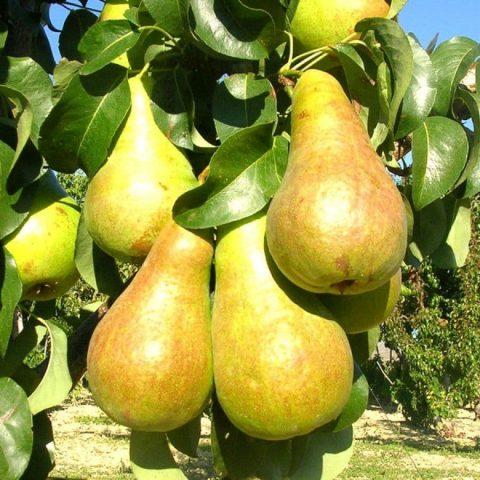
Delight is sensitive to drought and needs regular moisture
Varieties of self-fertile pears for the North-West
The best are considered to be pears zoned for the North-West, which do not require mandatory planting of pollinators nearby. Such varieties demonstrate regular fruiting even in cold weather, when insects hardly fly.
Kyrgyz winter
The productive variety has high endurance, is not afraid of winter frosts in the Leningrad region, and is not affected by fungi. Flowering occurs in May. The pear sets fruit on its own even in the absence of pollinators, although the latter increase its productivity.
In October, the harvest ripens; the variety bears fruits that are light green, oblong, with dense, sweetish and tart pulp. Fruits can remain in a cool room until April.

Kyrgyz winter can bear fruit annually for 30 years
Abbot Fetel
The medium-sized variety produces fairly large fruits of 250 g, elongated in shape, with yellow-green skin. The fruit tastes sweet with light sour and nutmeg notes.
This variety of pear has good immunity to fungi and is not affected by pests. It tolerates winter cold in the Leningrad region calmly with minimal insulation. It sets fruit without pollinators, the crop is stored for a long time and is suitable for transportation.
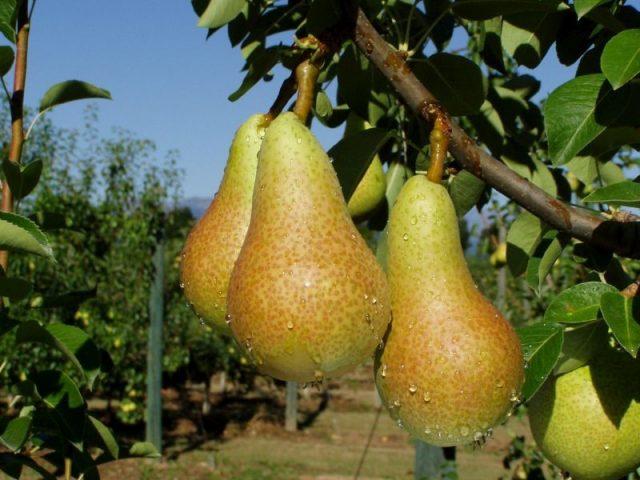
Abbot Fetel begins to bear fruit from the fourth year of life
Veles
The popular variety develops well in the Leningrad region and produces yellow-green large fruits of regular shape. The harvest is tasty, universally used, suitable for fresh consumption and for making compotes and jams.
The variety is frost-resistant, with strong immunity to fungi. Pears are grown not only for personal consumption, but also for sale due to their high yields.

Veles pear requires regular pruning; as the crown thickens, the fruits begin to shrink
When to plant a pear in the Leningrad region
You can plant a pear in the Leningrad region in early spring after the snow melts or in the fall about a month before the cold weather. Most often, gardeners choose the beginning of the season - in this case, the tree begins to bear fruit earlier.
Planting should be done in early or mid-May. It is necessary to wait until the end of night frosts - they pose a danger to young sensitive seedlings.
Planting pears in spring in the Leningrad region
To plant a pear in the North-West, you need to carefully select a site for the crop. During the growing process, a young tree requires good care.
Selection of seedlings
In the Leningrad region, it is recommended to place two-year-old pear seedlings in open ground. Before purchasing, the plant must be thoroughly inspected. A good pear should have a developed root system without rotten or dried shoots. It is desirable that the seedling has an even and strong trunk.
It is better not to use crooked, weakened specimens with traces of fungal diseases for planting. They will not be able to take root in the difficult conditions of the Leningrad region and will cause many problems when growing.
Selecting a location
The site for the pear is chosen to be open and sunny, but protected from drafts and cold winds. The crop needs well-drained soil; loam and sandy loam are best suited. It is better not to plant a pear on clay - moisture will accumulate in such soil, and sooner or later the roots of the tree will begin to rot.
Preparing the planting hole
The place for the pear is prepared several weeks before planting. In the selected area, dig a hole about 1 m in diameter and up to 70 cm deep. A drainage layer of pebbles or small crushed stone is placed at the bottom.
The top of the pit is half filled with nutrient substrate. It can be prepared from garden soil, humus and river sand, taken in approximately equal proportions. It is recommended to immediately install a support stake near the hole to secure the seedling. Young pears can bend and even break under strong winds.
Landing technology
You need to plant a pear in the Leningrad region according to the standard scheme:
- The soil in the prepared hole is moistened abundantly with lukewarm water.
- A pear seedling is dipped in a clay mash a few hours before planting.
- The plant is placed in the center of the hole and its roots are carefully spread to the sides.
- Sprinkle the seedling with the remaining soil and lightly compact the soil.
- Make grooves around the circumference in the root area and water.
To ensure that moisture from the ground evaporates more slowly, the seedling can be immediately mulched.
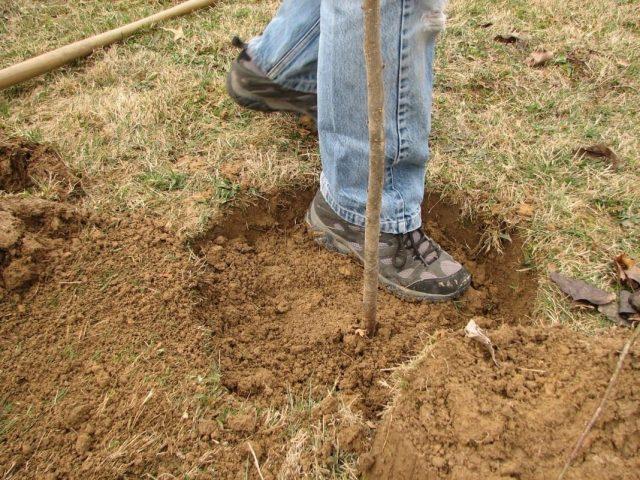
When planting, the root neck of the pear is left flush with the ground.
Rules of care
Growing pears in the Leningrad region follows simple rules. You need to pay attention to several nuances:
- Watering. In the Leningrad region, mostly drought-resistant pear varieties are planted that do not require frequent moisture. In addition, summers in the North-West are usually rainy. If there is a long absence of precipitation, trees can be watered once a week, but if the soil is already wet, the procedure should be abandoned.
- Feeding.On poor soil in the Leningrad region, pear varieties need regular fertilizers. In spring, trees are fed with mullein solution and complex minerals containing nitrogen. In autumn, attention is paid to phosphorus and potassium fertilizers.
- Trimming. Pear trees are trimmed twice a year - in early spring and late autumn. During the process, all dry, twisted and diseased shoots are cut off. It is also recommended to remove old skeletal branches every few years in order to rejuvenate the plant. The remaining shoots are trimmed at the tops to give the crown a neat shape.
With the onset of autumn, all plant debris is removed from the tree trunk circle, and the soil is thoroughly loosened. It is recommended to preventively treat the fruit tree with copper sulfate or Bordeaux mixture. In winter, the tree trunk circle is mulched with a dense layer of humus or dry foliage, and then the plant is covered with spruce branches. It is recommended to additionally cover young seedlings with non-woven material along the crown.
Conclusion
Planting pears in the spring in the Leningrad region is not associated with great difficulties. But you need to carefully choose the variety - it must be hardy and frost-resistant.
Reviews of pear varieties for the North-West



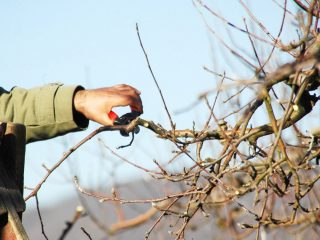
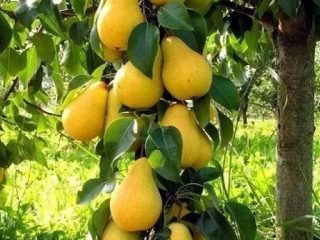




I would like to understand whether Chizhevskaya and Lada are suitable for us in the north or not?
Good afternoon.
Yes, they do.